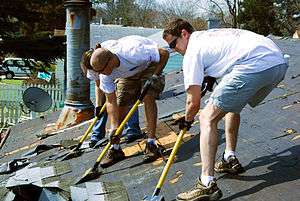Tar paper
Tar paper is a heavy-duty paper used in construction. Tar paper is made by impregnating paper or fiberglass mat with tar, producing a waterproof material useful for roof construction. Tar paper is distinguished from roofing felt which is impregnated with asphalt instead of tar; but these two products are used the same way, and their names sometimes are used informally as synonyms.
Tar paper has been in use for centuries. Originally felt was made from recycled rags but today felts are made of recycled paper products (typically cardboard) and sawdust. The most common product is #15 felt. Before the oil crisis, felt weighed about 15 pounds per square (one square = 100 square feet) and hence the asphalt-impregnated felt was called "15#" and "15-pound felt". Modern, inorganic mats no longer weigh 0.73 kg/m2, and to reflect this fact the new felts are called "#15". In fact, #15 mats can weigh from 7.5 to 12.5 pounds/sq depending on the manufacturer and the standard to which felt is made (i.e., CGSB, ASTM D227 Standard Specification for Coal-tar saturated Organic Felt Used in Roofing and Waterproofing, ASTM D4990, Standard Specification for Coal Tar Glass Felt Used in Roofing and Waterproofing, or none). Thirty-pound (30#) felt is now #30 felt, and usually weighs 16 to 27 pounds per square.
Tar paper is more accurately a Grade D building paper (the Grade D designation derives from a federal specification in the United States), which is widely used in the West. Building paper is manufactured from virgin kraft paper, unlike felts, and then impregnated with asphalt. The longer fibres in the kraft paper allow for a lighter weight product with similar and often better mechanical properties than felt. Grade papers are rated in minutes—the amount of time it takes for a moisture sensitive chemical indicator to change colour when a small boat-like sample is floated on water. Common grades include 10, 20, 30, and 60 minute. The higher the rating the more moisture resistant and the heavier. A typical 20 minute paper will weigh about 3.3 lbs per square, a 30-minute paper 3.75, and a 60-minute paper about six. The smaller volume of material, however, does tend to make these papers less resistant to moisture than heavier felts.
Uses

Tar paper is far less common than asphalt felt paper and is used, among other things, for waterproofing roofs to prevent ingress of moisture. It is used in a small percentage of built-up roofs (BUR), as underlayment with asphalt, wood, shake, and other shingles, or even gravel, since tar paper itself isn't particularly wind- or sun-resistant. It is sold in rolls of various widths, lengths, and thicknesses – 3-foot-wide (0.91 m) rolls, 50 or 100 feet (15 or 30 m) long and "15 lb" (7 kg) and "30 lb" (14 kg) weights are common in the U.S. – often marked with chalk lines at certain intervals to aid in laying it out straight on roofs with the proper overlap (more overlap for flatter roofs).
It can be installed in several ways, such as staples or roofing nails, but it is also sometimes applied in several layers with hot asphalt, cold asphalt (adhesive), or non-asphaltic adhesives.
Older construction sometimes used a lighter-weight tar paper, stapled up with some overlap, as a water- and wind-proofing material on walls, but modern carpenters more often uses 8-or-10-foot (2.4 or 3.0 m) widths of housewrap.